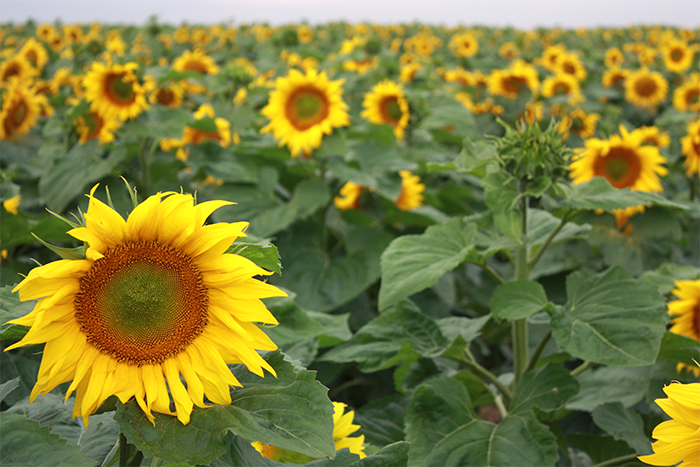Cool, wet weather in some areas and drought conditions in others hampered overall U.S. sunflower yield in 2014 for oil and confection varieties.
But at the end of the 2014 season, confection sunflower yield was higher, which means demand for oilseed sunflowers in 2015 will be stronger, says National Sunflower Association Executive Director John Sandbakken.
“It’s difficult to accurately predict future demand, but expectations are that, from 2016 onward, both the oil seed and confectionary sunflower markets will probably increase between 10% and 15% each year,” Sandbakken says. “That’s based on overall usage trends and considering where we’re at today with seed stocks.”
Confectionary sunflowers require some additional management time to avoid potential insect damage. However, markets typically pay a premium to compensate growers for the added labor.
Emergence of high oleic sunflower oil varieties coupled with growing demand for that type of oil is giving sunflower growers a new market opportunity.
“Some companies in the U.S. and overseas are looking for oil that is 7% or less saturated fat,” Sandbakken says. “Most oils can’t deliver that, but sunflower oil can. So our industry is seeing a move toward producing the sunflower varieties that provide high oleic oil.
“We expect to see more acres contracted for them in the years ahead. It’s definitely a new opportunity for sunflower growers.”

RAMPING UP. Since 2011, North Dakota slipped into second place as the leading sunflower growing state in the U.S. as growers there have battled excess rain and significant blackbird damage. But the expansion of sunflower seed markets is making sunflower production an attractive in North Dakota and across the U.S.
In central South Dakota, many growers produce confectionary sunflowers because drier, hotter weather conditions there aren’t as conducive to development of white mold and sclerotinia issues, which can hinder North Dakota confectionary growers.
Most confectionary seeds are sold as snack foods or used in processed foods such as granola bars, multi-grain breads and other baked goods.
“In the past, most sunflowers produced in my area were used either in the bird food market or were crushed for oil,” Young says. “Recently, the sunflower industry made a major change in the quality of sunflower oil produced. There is a growing demand for high oleic sunflower oil, which helps people manage levels of ‘good’ cholesterol. Many producers are transitioning to growing that type of sunflower.”
Improving Genetics
National Sunflower Association Board of Directors member and Syngenta representative Bill Gilbert says reviewing sunflower trial results can help in identifying an optimum variety for individual growers.
“For growers producing oil sunflowers, contract agreements will dictate variety traits,” Gilbert says. “The oil market is shifting away from NuSun to high oleic oil sunflower varieties. Many oil crushers are offering premiums for high oleic sunflower seed.
“New high oleic sunflower varieties are now producing yield similar to earlier NuSun and traditional sunflower varieties. Growers shouldn’t be concerned about looking at those newly traited high oleic products.”
Downy mildew can be prominent in cool, wet weather. Bion, a new seed treatment fungicide released by Syngenta in 2014, activates the sunflower’s natural resistance mechanisms to defend against all races of downy mildew. The new technology can be used in combination with CruiserMaxx Sunflower, Syngenta’s leading insecticide/fungicide seed treatment product.
“Once sunflower seeds are in the ground, there is no post-emergent defense against downy mildew,” Gilbert says. “Over the years, we’ve seen the disease rapidly evolve to render new variety traits ineffective. Bion seed treatment provides a second mode of action to help manage genetic resistance development.
“Bion testing has shown the new fungicide to be two or three times more effective than other products used in the past, so we’re moving all our seed care to Bion.”
CropPlan WinField Solutions representative Paul Gregor says his company now offers Pl 8 and Pl 15 downy mildew resistance in its varieties to help prevent the disease from advancing if plants become infected.
“Introducing plant resistance is an excellent option to combat downy mildew infections and is basic to disease control,” Gregor says. The sunflower industry as a whole is vigilant to improve downy mildew resistant sunflowers. Other sunflower diseases like phomopsis and sclerotinia aren’t as easy to manage with resistance traits, but we have some tolerance in most of our varieties.”
Gilbert advises that sunflower seed bag recommendations can greatly assist growers in selecting planting rates and appropriate plates since sunflower seeds don’t flow through planters as easily as corn and soybeans. Careful attention to recommendations aids with achieving satisfactory stands.
Clearfield Sunflower and Express Sun hybrids have been developed for use with Beyond and Express herbicides respectively for post emergence weed control. Both systems provide helpful tools in no-till operations to manage broadleaf and grassy weeds.
“Growers might encounter some limitations with resistant kochia or other resistant weed varieties,” Gilbert says. “Pre-emergence products like Spartan can help manage that issue. Syngenta recently acquired the rights to sell BroadAxe, a premix of the active ingredients in Dual Magnum (s-metolachlor) and Spartan (sulfentrazone) that provides dual broad spectrum control, including those resistant to Beyond or Express.”







Post a comment
Report Abusive Comment